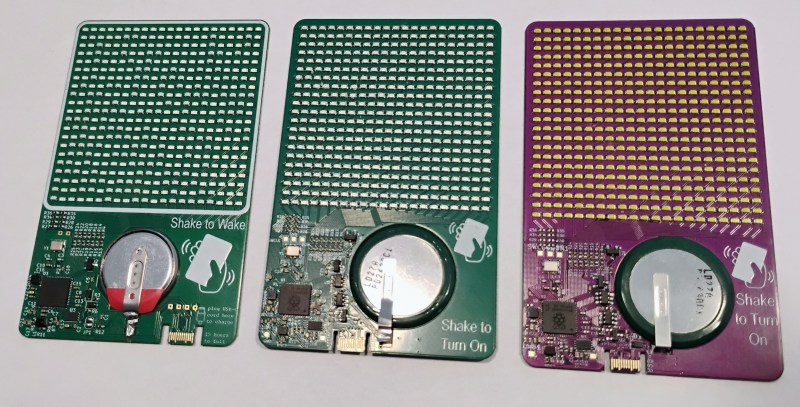Fluid-Implicit-Particle or FLIP is a method for simulating particle interactions in fluid dynamics, commonly used in visual effects for its speed. [Nick] adapted this technique into an impressive FLIP business card.
The first thing you’ll notice about this card is its 441 LEDs arranged in a 21×21 matrix. These LEDs are controlled by an Raspberry Pi RP2350, which interfaces with a LIS2DH12TR accelerometer to detect card movement and a small 32Mb memory chip. The centerpiece is a fluid simulation where tilting the card makes the LEDs flow like water in a container. Written in Rust, the firmware implements a FLIP simulation, treating the LEDs as particles in a virtual fluid for a natural, flowing effect.
This eye-catching business card uses clever tricks to stay slim. The PCB is just 0.6mm thick—compared to the standard 1.6mm—and the 3.6mm-thick 3.7V battery sits in a cutout to distribute its width across both sides of the board. The USB-C connection for charging and programming uses clever PCB cuts, allowing the plug to slide into place as if in a dedicated connector.
Inspired by a fluid simulation pendant we previously covered, this board is just as eye-catching. Thanks to [Nick] for sharing the design files for this unique business card. Check out other fluid dynamics projects we’ve featured in the past.
















That USB connector won’t last long. 0.6mm PCB is not very strong. It doesn’t look like it’s been made as a proper card edge connector either. The PCB would normally be beveled where they route off the shorting links for the hard gold plating.
It’s on github, i’m sure he would appreciate a PR.
I wonder if real EEs are like the armchair EEs of sites like this. it seems to be the case since I often see many a engineer trying to …well, overeingineer a solution. often because they believe, or were taught, the Right Way®
like for example worrying about the fragility of a gimmick business card that isn’t gonna be used more than a few times, or complaining that it doesn’t have a hard gold coating (a process that increases price by $200 for 10 units in PCBWAY last time I checked)
in a word, yes. there seems to be a massive disconnect between those having fun with PCB design and those insisting things can only be done The “Right” Way®, as you said. don’t let our fun get in the way of a good “whell acktually..”
An interesting idea would be making the board on a flexible pcb to make it thinnest as possible, and then glueing another pcb or a piece of 3d printed plastic on top so the components would be embedded inside the thick board. Also, it would allow the card to be covered with some sort of sticker, if needed of course, making a translucent display. There are many ideas to explore. Also, the board could have the power connectors as pins on the pcb so stacking then could charge all of them together at once.
That’s super cool. I guess? Could there be a link to see it working somewhere… or did I miss that?
https://github.com/Nicholas-L-Johnson/flip-card/blob/main/media/1000003136.gif
doing god’s work
Thank you for including said link that I specifically stated I couldn’t find.
Perhaps include the link, rather than making a statement that has no use?
The words “FLIP business card” at the end of the second sentence. There’s a rather large GIF at the very top of the README section on the linked Github page.
I, too, was surprised not to see a video embedded in the HaD article myself, so I used my mouse and its buttons to try clicking on links, and then the arrow keys on my keyboard to scroll. I can’t imagine the pain of having a zero-button mouse and a keyboard with no arrow keys.
I can’t imagine the pain of being so righteous that you didn’t just answer the question with humility, for those clearly inferior to yourself. But if making others feel bad is your thing, which it clearly is, then you do you.
The animated gif fails to work when viewing the content in the GitHub mobile app, and I’m forced to use the GitHub mobile app on my phone because of the url handling…
https://i.postimg.cc/fT9M7Nhq/1000003136-20250801020657.gif
thx, the first link gave a mostly empty page for me, so I searched the page source for “gif” and only found “/login?return_to…”, on which I decided to stop investigating
Given other commenters, I’m hesitant to ask, but – is there a writeup of the design process? The article header photo shows an interesting progression in versions.
Not all people here are…. unhelpful.
I am sure someone will help you out, have a great day!
Wireless charging, and Bluetooth, ditch the usb
I think it should have a wireless charger like for a Apple watch and also where they can upload their own art if they want to but it still advertised your advertisement every other minute so therefore it won’t be like a money’s worth waste for a motion charger by the motion of your leg every time you walk it charge or else it’s just going to be a useless card in someone’s wallet when they get ready to present it and show someone it’s not even going to turn on